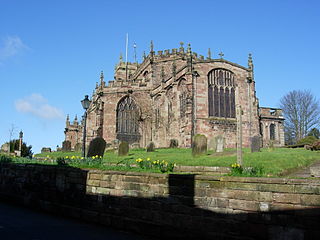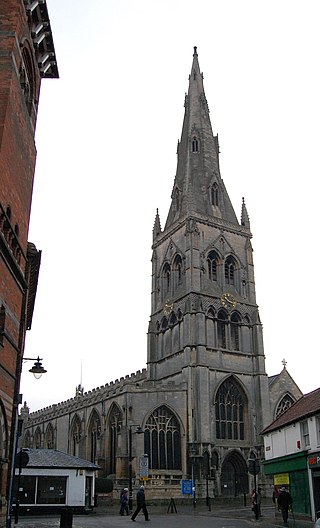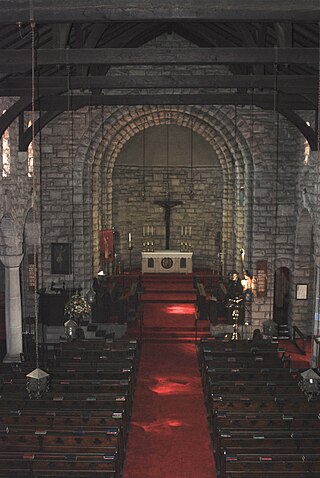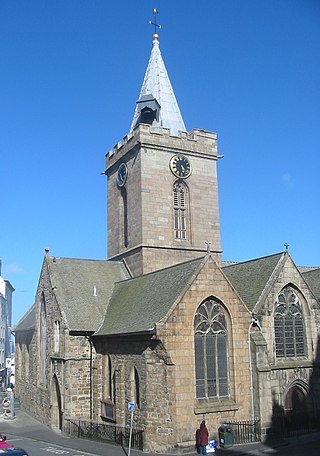
Saint Thomas Church is an Episcopal parish church of the Episcopal Diocese of New York at 53rd Street and Fifth Avenue in Midtown Manhattan, New York City. Also known as Saint Thomas Church Fifth Avenue or Saint Thomas Church in the City of New York, the parish was incorporated on January 9, 1824. The current structure, the congregation's fourth church, was designed by the architects Ralph Adams Cram and Bertram Grosvenor Goodhue in the French High Gothic Revival style and completed in 1914. In 2021, it reported 2,852 members, average attendance of 224, and $1,152,588 in plate and pledge income.

St. Mary's Church, Walthamstow, is a Church of England parish church in Walthamstow Village, a conservation area in Walthamstow, East London. It was founded in the 12th century and is still a working church. It retains over one hundred and fifty brasses and monuments, the oldest dating from 1436, though all that now remains of the original Norman church is some pillar bases and the chisel marks on them.

St Mary's, Harrow on the Hill, is the Borough and Parish Church at Harrow on the Hill in northwest London, England. It is a Grade I-listed building.

St Oswald's Church stands on the highest point in the market town of Malpas, Cheshire, England, on or near the site of a Norman motte and bailey castle. The church is recorded in the National Heritage List for England as a designated Grade I listed building and is recognised as being one of the best examples in Cheshire of a late 15th to early 16th-century church. It is an active Anglican parish church in the diocese of Chester, the archdeaconry of Chester and the deanery of Malpas. Its benefice is combined with those of St John, Threapwood, and Holy Trinity, Bickerton. Alec Clifton-Taylor includes it in his list of 'best' English parish churches.

The Parish Church of St Margaret is a Church of England parish church situated on St Margaret's Road, off Bury Old Road (A665) in Prestwich, Greater Manchester, England. The Grade II listed church, in the Diocese of Manchester, was designed in the Decorated style by the Manchester architects Travis and Mangnall in 1849 as a chapel-of-ease to the ancient Prestwich Parish Church of St Mary the Virgin. Opened in 1851, it was extended in 1863, 1871, 1884, 1888 and 1899, and is notable for its fine Arts and Crafts wood carvings by Arthur Simpson of Kendal and late twentieth-century fittings. The church's daughter church of St George, Simister, is in the same parish.

St Brelade's Church is one of the twelve ancient parish churches in the island of Jersey; it is sited on the west side of the island in the parish of St Brelade, in the southwest corner of St Brelade's Bay. It is unique in the Channel Islands in having one of the very few surviving medieval chapels, the Fisherman's Chapel, sited directly next to the main church building.

St Helen Witton Church, Northwich, is in the centre of the town of Northwich, Cheshire, England. It is recorded in the National Heritage List for England as a designated Grade I listed building. The church is now known as "St Helen's, Witton" or "Northwich Parish Church". It is an active Anglican parish church in the diocese of Chester, the archdeaconry of Chester and the deanery of Middlewich. Alec Clifton-Taylor includes it in his list of 'best' English parish churches.

St Mary Magdalene Church, Newark-on-Trent is the parish church of Newark-on-Trent in Nottinghamshire, England. It is dedicated to Mary Magdalene and is the tallest structure in the town.

Calvary Episcopal Church is a parish of the Episcopal Diocese of Pittsburgh, Pennsylvania. The parish was founded in 1855.

St Boniface Church is the mother church of the Anglican parish of Germiston, Gauteng which also includes the chapelries of St Mary and St John in Lambton, and St Mark in Rosedeep. The parish is part of the Diocese of the Highveld, which is in turn part of the Anglican Church of Southern Africa.

St Mary's, Staines, is a Church of England parish church in the town and parish of Staines-upon-Thames, in the Spelthorne borough of Surrey and the Greater London Urban Area. The parish is in the Archdeaconry of Middlesex in the Diocese of London. The church building is on an unusual rise against the Thames at the west end of the town. It has been a Grade II* listed building since 11 August 1952.

St James' Church is in the village of Brindle, Lancashire, England. It is an active Anglican parish church in the deanery of Chorley, the archdeaconry of Blackburn, and the diocese of Blackburn. The church is recorded in the National Heritage List for England as a designated Grade II listed building.

The Parish Church of All Saints' Lawshall, is an Anglican church in the village of Lawshall, Suffolk, England. It has been designated by English Heritage as a Grade I listed building. The church is located in between Lawshall Hall and All Saints CEVCP Primary School. The church is in the process of joining the Chadbrooke benefice, whose Rector is Revd Matthew Lawson.

Saint Thomas's Church is a historic Roman Catholic church in St. Helier, Jersey. It is the largest church in the Channel Islands, and first opened its doors in 1887.

The Cathedral Church of St. Peter is an Episcopal cathedral in St. Petersburg, Florida, United States. It is the seat of the Diocese of Southwest Florida. In 2004 it was included as a contributing property in the Downtown St. Petersburg Historic District on the National Register of Historic Places.

St Mary's Church is a Grade I listed building, a parish church in the Church of England in Ottery St Mary, Devon.
![<span class="mw-page-title-main">St Botolph's Church, Quarrington</span> Church in Quarrington, [[Lincolnshire]], England](https://upload.wikimedia.org/wikipedia/commons/thumb/a/a4/Quarrington%2C_St_Botolph%27s_church_-_49697149402.jpg/320px-Quarrington%2C_St_Botolph%27s_church_-_49697149402.jpg)
St Botolph's Church is an Anglican church in Quarrington in Lincolnshire, England. The area has been settled since at least the Anglo-Saxon period, and a church existed at Quarrington by the time the Domesday Book was compiled in 1086, when it formed part of Ramsey Abbey's fee. It was granted to Haverholme Priory in 1165, and the Abbey claimed the right to present the rector in the 13th century.

The Town Church is also known as the "Parish Church of St Peter Port", "Sancti Petri du Portu" and "Town Church of St Peter, Apostle & Martyr".

St Mary's Church, Market Drayton, stands on the top of a prominent outcrop of red sandstone rock above the River Tern. The church is recorded in the National Heritage List for England as a designated Grade II* listed building.

St. John's Episcopal Church, Georgetown, is a parish of the Episcopal Church located in the Georgetown neighborhood of Washington, D.C. Original plans for the church date to 1769, and the parish church was officially founded by Walter Dulany Addison in 1796. The church building was designed by architect William Thornton in the Federal style and was structurally completed in 1804, to be consecrated in 1809.























![<span class="mw-page-title-main">St Botolph's Church, Quarrington</span> Church in Quarrington, [[Lincolnshire]], England](https://upload.wikimedia.org/wikipedia/commons/thumb/a/a4/Quarrington%2C_St_Botolph%27s_church_-_49697149402.jpg/320px-Quarrington%2C_St_Botolph%27s_church_-_49697149402.jpg)


